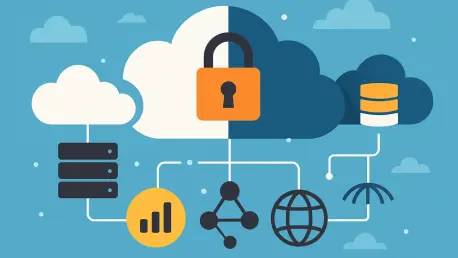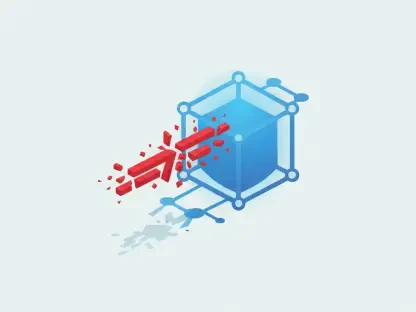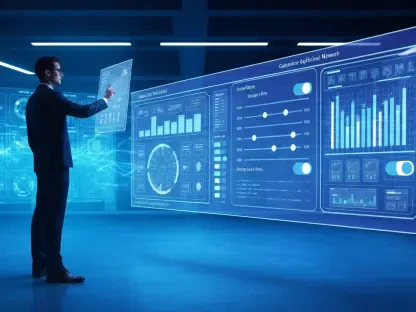In an era where data is the lifeblood of enterprises, staying ahead of storage and protection trends is more critical than ever, especially as the week of August 1 reveals a flurry of transformative developments that promise to reshape how businesses manage and secure their information. The tech landscape is buzzing with innovations, from cutting-edge hybrid cloud solutions to the complex interplay of artificial intelligence in cybersecurity. This period highlights not only the strides made by industry leaders but also the escalating challenges posed by sophisticated threats targeting vulnerable sectors. As companies grapple with balancing efficiency and security, the latest updates from major players like Hitachi Vantara, IBM, and others provide a window into the strategies shaping the future. These advancements, coupled with alarming reports on ransomware and strategic industry shifts, paint a vivid picture of a sector at a pivotal moment, striving to adapt to relentless digital demands while safeguarding against ever-evolving risks.
The stakes have never been higher, with data breaches costing millions and disrupting operations on a global scale. This week’s news underscores a dual reality: remarkable technological progress alongside persistent vulnerabilities that demand immediate attention. Whether it’s the push for seamless data mobility or the urgent need to counter AI-driven attacks, the insights gathered here are essential for any organization aiming to thrive in a data-centric world. Let’s delve into the key areas driving this dynamic field, exploring how hybrid environments, cybersecurity threats, AI’s dual role, and strategic maneuvers are defining the path forward for storage and data protection.
Advancements in Storage Infrastructure
Hybrid Cloud Innovations
The momentum behind hybrid cloud solutions is undeniable, as vendors roll out platforms designed to bridge on-premises and cloud environments with unprecedented efficiency. Hitachi Vantara has taken a significant step with the launch of its Virtual Storage Platform One Software-Defined Storage on Google Cloud Marketplace, a solution that promises up to 40% cost reduction through features like asynchronous replication and advanced compression. This offering also guarantees near-perfect uptime at 99.999%, addressing the critical need for reliability in enterprise data management. Meanwhile, US Signal’s new Infrastructure Service Platform, powered by Infinidat’s technology, focuses on multi-petabyte storage capabilities tailored for hybrid setups. This reflects a broader industry trend toward unified systems that prioritize flexibility and resilience, ensuring businesses can manage sprawling data landscapes without sacrificing performance or security.
Beyond individual product launches, the emphasis on hybrid cloud signals a strategic shift in how enterprises approach data mobility and cost management. The integration of on-premises infrastructure with cloud environments isn’t just about convenience; it’s a response to the growing complexity of workloads that demand seamless transitions across platforms. These solutions are engineered to minimize downtime and optimize resource allocation, a necessity as companies scale operations globally. Moreover, the focus on cyber resilience embedded in these platforms highlights an awareness of the risks tied to expanded digital footprints. As more organizations adopt this model, the challenge lies in maintaining robust security protocols across diverse environments, a concern that vendors are increasingly addressing through built-in safeguards and partnerships aimed at fortifying data integrity.
Scalability for Modern Demands
Meeting the demands of AI and analytics-driven workloads is pushing storage technology to new heights, with performance and scalability at the forefront of innovation. Lightbits’ NVMe-over-TCP platform stands out by delivering low-latency access for data centers, a critical feature for applications requiring rapid data processing at reduced costs. This approach caters to the intense needs of modern enterprises where speed can determine competitive advantage. Similarly, Scality’s open-source COSI and CSI drivers for Kubernetes facilitate seamless object and file storage provisioning in cloud-native setups, ensuring that businesses can scale effortlessly as data volumes surge. These developments underscore the industry’s recognition that static storage systems are no longer viable in a world dominated by dynamic, data-intensive tasks.
Furthering this conversation, upcoming industry gatherings like Supermicro’s Open Storage Summit are set to explore how AI workloads are reshaping storage infrastructure requirements. Topics such as distributed inference, generative AI, and storage-as-a-service models will take center stage, reflecting the urgency to adapt to evolving technological paradigms. These discussions are not merely academic; they aim to address real-world challenges faced by organizations struggling to balance cost with capability. The push for scalable solutions also brings into focus the need for interoperability, as disparate systems must work cohesively to support sprawling AI ecosystems. As enterprises navigate this terrain, the innovations highlighted this week offer a blueprint for building infrastructure that can withstand the pressures of tomorrow’s digital demands while maintaining efficiency.
Cybersecurity and AI Dynamics
Rising Ransomware Threats
Cybersecurity remains a pressing issue as ransomware continues to wreak havoc, particularly targeting government entities with alarming frequency. A recent report from Comparitech for this year reveals a stark rise in attack incidents, coupled with escalating ransom demands and frequent data exposures that leave sensitive information vulnerable. Public agencies, often under-resourced in terms of digital defenses, face an uphill battle against these sophisticated threats, prompting calls for urgent reinforcement of protective measures. This trend isn’t just a statistic; it’s a wake-up call for all sectors to reassess their vulnerability to extortion schemes that can cripple operations and erode public trust. The financial and reputational costs of these breaches are staggering, emphasizing the need for proactive strategies over reactive damage control.
In response to this growing menace, vendors are stepping up with enhanced tools designed to fortify data protection. Backblaze’s latest platform update introduces advanced access controls and detailed audit logging, features aimed at strengthening compliance and safeguarding business data against unauthorized access. These enhancements are a direct countermeasure to the evolving tactics of cybercriminals who exploit even the smallest gaps in security. The focus on real-time monitoring and granular control reflects an understanding that prevention is far more effective than recovery in the ransomware landscape. As threats become more targeted, such updates are vital for organizations aiming to stay one step ahead, ensuring that their data remains secure even as attackers refine their methods to exploit systemic weaknesses.
Human-Centric Security Solutions
Addressing cybersecurity isn’t solely about technology; human behavior plays a pivotal role in creating or mitigating risks, often serving as the weakest link in the chain. KnowBe4’s innovative integration of SecurityCoach with Microsoft Edge for Business tackles this issue head-on by offering real-time coaching to users, specifically targeting browser-based vulnerabilities that are frequently exploited. This tool provides immediate guidance during risky online interactions, empowering employees to make safer decisions without disrupting workflows. By focusing on education at the point of action, this approach aims to reduce the incidence of human error, which remains a primary entry point for phishing and other social engineering attacks that can lead to devastating breaches.
This shift toward human-centric security solutions marks a broader recognition that technical safeguards alone cannot fully protect an organization. Educating users in real time fosters a culture of awareness that complements firewalls and encryption, creating a multi-layered defense strategy. The significance of such tools lies in their ability to adapt to individual behaviors, offering personalized feedback that resonates more effectively than generic training sessions. As cyber threats increasingly prey on human oversight, integrating behavioral coaching into everyday tools becomes a critical component of comprehensive security frameworks. This week’s developments highlight how blending technology with human-focused initiatives can build resilience against threats that exploit both digital and psychological vulnerabilities.
AI as Threat and Defense
Artificial intelligence is proving to be a double-edged sword in the realm of data protection, simultaneously accelerating threats and enhancing defenses in ways previously unimaginable. IBM’s latest “Cost of a Data Breach” report for this year indicates that AI-powered attacks have shortened breach lifecycles by 17%, intensifying the speed and cost of incidents for affected organizations. This acceleration means that attackers can infiltrate systems and extract value faster, leaving less time for detection and response. However, the same report also points to AI’s potential in bolstering security, with advanced algorithms enabling quicker identification of anomalies and more effective threat mitigation. This duality presents a complex challenge for enterprises striving to stay secure in an AI-driven era.
Complementing these findings, expert discussions on The Cyber Circuit podcast delve into how AI-augmented decision support is transforming enterprise security. By leveraging machine learning to analyze vast datasets in real time, organizations can drastically cut response times to potential breaches, a game-changer in high-stakes environments. This capability allows for predictive insights that anticipate threats before they materialize, shifting the paradigm from reaction to prevention. Yet, the reliance on AI also introduces new risks, as adversaries use similar technologies to craft more sophisticated attacks. The industry must navigate this tightrope, ensuring that defensive applications of AI keep pace with, or ideally outstrip, the offensive strategies employed by malicious actors. This balance is central to shaping a future where technology serves as a shield rather than a weapon.
Governing AI Risks
As AI’s influence on data protection grows, so does the imperative for robust governance to curb its potential downsides. Invariant Labs’ research into ‘toxic flow analysis’ offers a forward-thinking method to detect harmful data flows within AI systems, a proactive step toward identifying risks before they escalate into full-blown crises. This approach focuses on scrutinizing the pathways through which data moves, flagging anomalies that could indicate malicious intent or systemic flaws. With AI adoption accelerating across industries, such methodologies are crucial for ensuring that systems remain trustworthy, particularly when handling sensitive information. Governance isn’t just a regulatory checkbox; it’s a foundational element for maintaining confidence in AI-driven processes.
The conversation around AI governance also extends to establishing frameworks that can adapt to rapid technological change. Without clear guidelines, the benefits of AI in security could be undermined by vulnerabilities that attackers exploit, creating a cycle of innovation and risk. Industry stakeholders are increasingly advocating for standardized protocols to assess and mitigate these dangers, ensuring that AI tools are deployed responsibly. This includes transparency in how algorithms operate and accountability for their outcomes, aspects that are often opaque in complex systems. As highlighted in recent discussions, striking a balance between harnessing AI’s capabilities and safeguarding against its misuse is a defining challenge. The push for oversight reflects a maturing understanding that unchecked technology can amplify threats as much as it resolves them.
Strategic Shifts and Industry Collaboration
Organizational Growth and Adaptation
Strategic organizational changes are playing a vital role in helping companies meet the escalating global demand for robust data protection and recovery solutions. Assured Data Protection’s recent leadership restructuring, including the appointment of Stacy Hayes as Chief Strategy Officer and new Chief Revenue Officers for key regions, demonstrates a deliberate focus on expanding cloud-based services. These moves, supported by fresh investments and strategic partnerships, are designed to enhance disaster recovery offerings at a time when businesses face mounting pressure to safeguard data against disruptions. Such adaptations signal an industry-wide acknowledgment that staying competitive requires not just technological innovation but also structural agility to address diverse market needs.
These leadership shifts are more than cosmetic; they reflect a deeper commitment to aligning corporate strategies with the evolving landscape of data security. By positioning experienced leaders in critical roles, companies aim to drive innovation in areas like cloud protection, where demand is surging due to increased remote operations and digital transformation. This also involves cultivating partnerships that extend reach and expertise, ensuring that solutions are both comprehensive and accessible. The emphasis on strategic growth highlights a proactive stance, preparing for future challenges by building capacity now. As global threats and data volumes grow, such organizational foresight becomes indispensable for maintaining trust and delivering reliable services to clients across sectors.
Collaboration and Learning Opportunities
Industry events are emerging as crucial platforms for fostering dialogue and collaboration on the complex challenges facing storage and data protection. Supermicro’s forthcoming Open Storage Summit is poised to tackle the profound impact of AI workloads on infrastructure, with sessions dedicated to generative AI, distributed inference, and storage-as-a-service models. These gatherings provide a space for thought leaders and practitioners to exchange ideas on adapting to data-intensive environments, offering insights that can shape practical solutions. The focus on collaborative learning underscores the importance of collective progress in an industry where isolated efforts often fall short against multifaceted threats and technological shifts.
Beyond knowledge sharing, these events serve as catalysts for innovation by connecting diverse stakeholders who bring unique perspectives to the table. The discussions at such summits often lead to partnerships and initiatives that address gaps in current offerings, particularly in how storage systems can support AI-driven demands without compromising security. This collaborative spirit is essential for developing standards and best practices that benefit the entire ecosystem, from vendors to end-users. Moreover, they highlight the necessity of staying informed in a rapidly changing field, where yesterday’s solutions may not address tomorrow’s problems. As the industry navigates this dynamic terrain, platforms for engagement and idea exchange are proving to be as valuable as the technologies themselves.
Reflecting on a Transformative Week
Looking back at the developments from the week of August 1, the storage and data protection sector showcased a remarkable blend of innovation and urgency that defined its response to contemporary challenges. Hybrid cloud advancements, fortified cybersecurity measures, and the nuanced role of AI in both threat and defense painted a landscape of relentless progress tempered by significant risks. Vendors and researchers alike demonstrated a commitment to addressing ransomware surges and scalability demands through targeted solutions and strategic foresight. Organizational restructurings and collaborative events further cemented the industry’s resolve to adapt, ensuring that global demands for secure, efficient data management were met with actionable strategies. Moving forward, the focus should shift to integrating these innovations into cohesive frameworks that prioritize long-term resilience. Enterprises must invest in both technology and education, fostering environments where human and digital defenses work in tandem to anticipate threats. As the dialogue continues through summits and reports, the path ahead lies in sustained collaboration and proactive governance to navigate an increasingly complex digital future.









